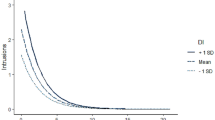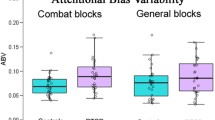Abstract
Intrusive thoughts have been identified as key elements of chronic or traumatic stress, but many questions remain about how they operate and what causes persistence of disturbing intrusions. The present study considers these questions, examining the impact of having intrusive thoughts that are cued by stimuli in one's environment as opposed to uncued intrusions that seem to “come out of the blue.” In addition, this research evaluates the extent to which distress accompanying intrusive thoughts shortly after a traumatic event predicts persistence of intrusions over time. Rescue workers who responded to the crash of Flight 427 were studied 4 to 8 weeks, and 6, 9, and 12 months after the disaster. Participants who reported crash-related thoughts that were not prompted by cues showed higher levels of distress than those reporting only cued thoughts or those reporting neither. The magnitude of distress that these thoughts caused in the first 2 months after the crash was important in predicting subsequent frequency of unwanted thoughts. The presence or absence of cues and their role in the maintenance of distress also is discussed.
Similar content being viewed by others
References
Baum, A. (1990). Stress, intrusive imagery, and chronic distress. Health Psychology, 9, 653–675.
Baum, A., Cohen, L., & Hall, M. (1993). Control and intrusive memories as possible determinants of chronic stress. Psychosomatic Medicine, 55, 279–286.
Delahanty, D., Dougall, A. L., Craig, K. J., Jenkins, F. J., & Baum, A. (1997). Chronic stress and natural killer cell activity following exposure to traumatic death. Psychosomatic Medicine, 59, 467–476.
Derogatis, L. R. (1977). The SCL-90-R administration, scoring, and procedures manual-I. Baltimore, MD: Clinical Psychometric Research Unit, Johns Hopkins University.
Dougall, A. L., Craig, K. J., & Baum, A. (1999). Assessment of characteristics of intrusive thoughts and their impact on distress among victims of traumatic events. Psychosomatic Medicine, 61(1), 38–48.
Easterbrook, J. A. (1959). The effect of emotion on cue utilization and the organization of behavior. Psychological Review, 66, 183–201.
Foa, E. B., & Riggs, D. S. (1995). Posttraumatic stress disorder following assault: Theoretical considerations and empirical findings. Current Directions in Psychological Science, 4(2), 61–65.
Glass, D. C., Reim, B., & Singer, J. E. (1971). Behavioral consequences of adaptation to controllable and uncontrollable noise. Journal of Experimental Social Psychology, 7, 244–257.
Gold, P. E., & McGaugh, J. L. (1975). A single-trace, two process view of memory storage processes. In D. Deutsch & J. A. Deutsch (eds.), Short-term memory. New York: Academic Press.
Horowitz, M. J. (1986). Stress response syndromes. New York: Aronson.
Horowitz, M. J. (1990). Posttraumatic stress disorders: Psychosocial aspects of the diagnosis. International Journal of Mental Health, 19, 21–36.
Horowitz, M., Wilner, N., & Alvarez, W. (1979). Impact of Event Scale: A measure of subjective stress. Psychosomatic Medicine, 41, 209–218.
Lang, P. (1979). A bio-informational theory of emotional imagery. Psychophysiology, 16, 495–512.
LeDoux, J. E. (1992). Emotion as memory: Anatomical subsystemc underlying indelible neural traces. In S. A. Christianson (ed.), The Handbook of Emotion and Memory: Research and Theory. Hillsdale, NJ: Lawrence Erlbaum Associates.
Lepore, S. J., Silver, R. C., Wortman, C. B., & Wayment, H. A. (1996). Social constraints, intrusive thoughts, and depressive symptoms among bereaved mothers. Journal of Personality and Social Psychology, 70, 271–282.
Litz, B. T., & Keane, T. M. (1989). Information processing in anxiety disorders: Application to the understanding of posttraumatic stress disorder. Clinical Psychology Review, 9, 243–257.
Mathews, A., & MacLeod, C. (1985). Selective processing of threat cues in anxiety states. Behaviour Research & Therapy, 23(5), 563–569.
McGaugh, J. L. (1992). Affect, neuromodulatory systems, & memory storage. In S. A. Christianson (ed.), The Handbook of Emotion and Memory: Research and Theory.??? Hillsdale, NJ: Lawrence Erlbaum Associates.
Miles, M. S., Demi, A. S., & Mostyn-Aker, P. (1984). Rescue worker's reactions following the Hyatt Hotel disaster. Death Education, 8, 315–331.
Pittman, R. K., Orr, S. P., Forgue, D. F., deJong, J. B., & Claiborn, J. M. (1987). Psychophysiologic assessment of posttraumatic stress disorder imagery in Vietnam combat veterans. Archives of General Psychiatry, 44, 970–975.
Taylor, A. J. W., & Frazer, A. G. (1982). The stress of postdisaster body handling and victim identification work. Journal of Human Stress, 8, 4–12.
Ursano, R. J., McCaughey, B. G., & Fullerton, C. S. (1994). Individual and community responses to trauma and disaster: The structure of human chaos. Cambridge, England, UK: Cambridge University Press.
van der Kolk, B. A., & Fisler, R. (1995). Dissociation and the fragmentary nature of traumatic memory: Overview and exploratory study. Journal of Traumatic Stress, 8, 607–627.
Vitaliano, P. P., Russo, J., Weber, L., & Celum, C. (1993). The Dimensions of Stress Scale: Psychometric properties. Journal of Applied Social Psychology, 23, 1847–1878.
Wegner, D. M. (1994). Ironic processes of mental control. Psychological Review, 101, 34–52.
Zimering, R. T., Caddell, J. M., Fairbank, J. A., & Keane, T. M. (1993). Posttraumatic stress disorder in Vietnam veterans: An experimental validation of the DSM-III diagnostic criteria. Journal of Traumatic Stress, 6, 327–342.
Author information
Authors and Affiliations
Corresponding author
About this article
Cite this article
Schooler, T.Y., Dougall, A.L. & Baum, A. Cues, Frequency, and the Disturbing Nature of Intrusive Thoughts: Patterns Seen in Rescue Workers After the Crash of Flight 427. J Trauma Stress 12, 571–585 (1999). https://doi.org/10.1023/A:1024756832073
Issue Date:
DOI: https://doi.org/10.1023/A:1024756832073




